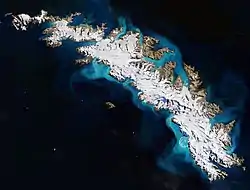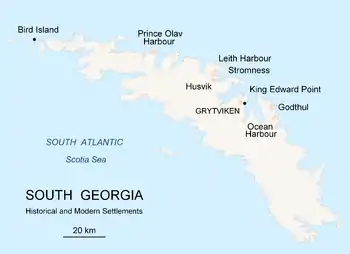South Georgia (island)
South Georgia (Spanish: Isla San Pedro) is an island in the southern Atlantic Ocean that is part of the British Overseas Territory of South Georgia and the South Sandwich Islands. The main settlement is Grytviken. South Georgia is 167.4 kilometres (104 mi) long and 1.4 to 37 km (0.9 to 23.0 miles) wide.[1] It is about 830 km (520 mi) northeast of Coronation Island and 550 km (340 mi) northwest from Zavodovski Island, the nearest South Sandwich island.
 South Georgia | |
 Map of South Georgia Island | |
| Geography | |
|---|---|
| Location | South Atlantic |
| Coordinates | 54.4°S 36.7°W |
| Archipelago | South Georgia group |
| Area | 3,528 km2 (1,362 sq mi) |
| Length | 167.4 km (104.02 mi) |
| Width | 37 km (23 mi) |
| Highest elevation | 2,934 m (9626 ft) |
| Highest point | Mount Paget |
| Largest settlement | King Edward Point |
| Demographics | |
| Population | 32 (summer) 16 (winter) |
History
The island of South Georgia was probably discovered in 1675 by Anthony de la Roché,[2] a London merchant, and was named Roche Island on a number of early maps. It was sighted by a commercial Spanish ship named León operating out of Saint-Malo on 28 June or 29 June 1756.[3] According to Argentine historians, it was explored on 29 June 1756, St Peter's Day, hence its Spanish name Isla San Pedro, literally "St Peter's Island".[4]
Commercial sealing was conducted on the island between 1786 and 1913. During that period 131 sealing visits are recorded, eight of which ended when the vessel was wrecked.[5] Modern industrial sealing associated with whaling stations was carried out between 1909 and 1964. Sealing era relics include iron try pots, hut ruins, graves and inscriptions.
Argentine occupation
On 19 March 1982, a group of Argentinians arrived at Leith Harbour and raised the Argentine flag on the island. On 3 April, the second day of the Falklands War, Argentine naval forces occupied the island. South Georgia was retaken by British forces on 25 April during Operation Paraquet.[6]
Geography and fauna

The island is classified as an ET or polar tundra climate on the Köppen-Geiger classification system. It has no tree cover, and there is generally snow on the island during the winter months (April–November). The terrain is mountainous, with a central ridge and many fjords and bays along the coast. Additionally, South Georgia is a breeding ground for elephant seals,[7] fur seals,[8][9] and king penguins. The island is home to the South Georgia Pintail and the South Georgia Pipit, the only known habitat for these birds.[10]
There are 25 native vascular plants on South Georgia, and 76 non-native species have been recorded.[11][12]
The island's topography includes a stepped sequence of flat surfaces interpreted as wave-cut platforms formed when sea level was higher relative to the island. At sea level strandflats have been described.[13]
In 2013, teams of Norwegian government shooters and Sami reindeer herders culled all 3,500 reindeer on the island. The animals had been introduced by Norwegian whalers in the early 20th century for food and sport hunting, but were later seen as a pest, damaging the island's flora and wider ecosystem. Karl Erik Kilander, the project manager, said the culled reindeer were frozen and taken to the Falkland Islands where they were sold to local residents and cruise ship operators.[14]
In 2018, after a multiyear extermination effort, the island was declared free of invasive rodents and the number of South Georgia Pipits had clearly increased.[15][16][17]
The island lies in the path of large icebergs drifting northward from Antarctica. Iceberg A-38 grounded off the island in 2004, resulting in indirect but severe effects on local wildlife; in 2020, the colossal 4,200 square kilometres (1,600 sq mi) Iceberg A-68, similar in size to the island itself, was initially believed to be on a similar collision course but broke apart before collision with the island.[18][19][20]
References
- "Google Maps". Google Maps. Retrieved 2017-07-18.
- Hayward, R.J.C. (1983). "Glacier fluctuations in South Georgia, 1883–1974" (PDF). British Antarctic Survey Bulletin (52): 47. Retrieved 25 December 2020.
- "Historia General de las Relaciones Exteriores de la República Argentina: Georgias del Sur" [General History of Foreign Relations of the Argentine Republic: South Georgia Islands]. www.argentina-rree.com (in Spanish). Instituto Iberoamérica y el Mundo. Retrieved 2017-07-18.
- Destéfani, Laurio Hedelvio (1982). Malvinas, Georgias y Sandwich del Sur ante el conflicto con Gran Bretaña (in Spanish). Buenos Aires: Edipress. p. 111. ISBN 9500169002.
- R.K. Headland, (ed.) Historical Antarctic sealing industry, Scott Polar Research Institute (Cambridge University), 2018, p.168, ISBN 978-0-901021-26-7.
- Freedman, Lawrence (2005). The Official History of the Falklands Campaign: The origins of the Falklands war. Routledge. p. 222. ISBN 0-7146-5206-7.
- Boyd, I. L., Walker, T. R., & Poncet, J. (1996). Status of southern elephant seals at South Georgia. Antarctic Science, 8(3), 237–244. doi:10.1017/S0954102096000338
- Boyd, I. L., McCafferty, D. J., & Walker, T. R. (1997). Variation in foraging effort by lactating Antarctic fur seals: response to simulated increased foraging costs. Behavioral Ecology and Sociobiology, 40(3), 135–144. doi:10.1007/s002650050326
- Boyd, I. L., McCafferty, D. J., Reid, K., Taylor, R., & Walker, T. R. (1998). Dispersal of male and female Antarctic fur seals (Arctocephalus gazella). Canadian Journal of Fisheries and Aquatic Sciences, 55(4), 845–852. doi:10.1139/f97-314
- Amos, Jonathan (2018-05-09). "Rodents driven from South Georgia". BBC News. Retrieved 2018-05-09.
- Galbraith, Deirdre. (2011). A field guide to the flora of South Georgia. Great Britain: South Geogia Heritage Trust. ISBN 978-0-9564546-0-7. OCLC 714041780.
- Upson, Rebecca,. Field guide to the introduced flora of South Georgia. Myer, Bradley,, Floyd, Kelvin,, Lee, Jennifer,, Clubbe, Colin,. Richmond, Surrey, UK. ISBN 978-1-84246-652-0. OCLC 1007331209.CS1 maint: extra punctuation (link) CS1 maint: multiple names: authors list (link)
- Chalmers, M.; Clapperton, M.A. (1970). Geomorhpology of the Stromness Bay – Cumberland Bay area, South Georgia (PDF) (Report). British Antarctic Survey Scientific Reports. 70. pp. 1–25. Retrieved January 29, 2018.
- Bazilchuk, Nancy (2013). "Reining in Reindeer on South Georgia Island". Frontiers in Ecology and the Environment. 11 (4): 176. JSTOR 23470940.
- Warren, Matt (2018-05-08). "Rat begone: Record eradication effort rids sub-Antarctic island of invasive rodents". Science. Retrieved 2018-05-09.
- "The Intrepid Rat-Sniffing Terriers of South Georgia Island". atlasobscura.com. 17 May 2018.
- Marris, Emma (11 May 2018). "Birdlife Recovering on Rat-Free Island". National Geographic. Retrieved 6 July 2020.
- Jonathan Amos (4 November 2020). "A68 iceberg on collision path with South Georgia". BBC. Retrieved 4 November 2020.
- European Space Agency (10 November 2020). "Giant berg on collision course with South Georgia". www.esa.int. Retrieved 10 November 2020.
- "Penguins Spared After Mammoth Iceberg Splits Into Smaller Pieces". The Wall Street Journal. February 6, 2021. Retrieved 6 February 2021.
Further reading
- Chisholm, Hugh, ed. (1911). . Encyclopædia Britannica. 25 (11th ed.). Cambridge University Press. p. 513.
